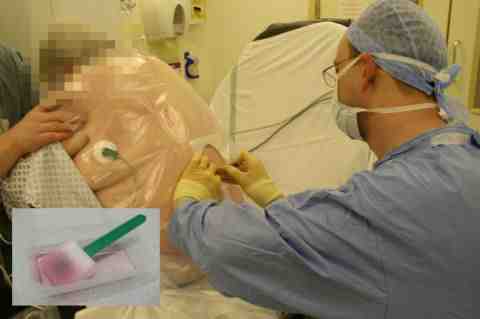Asepsis

Fig 1 Asepsis during neuraxial block (in this case a spinal). The operator is wearing hat, mask, gown and gloves. A fenestrated drape has been used. The back was cleaned using chlorhexidine in alcohol (inset)
Asepsis
There are two aspects to consider:
- Operator. It is highly recommended that the operator scrub thoroughly as if for surgery, and don hat, mask, sterile gown and gloves. These are quick and simple precautions which can only benefit the patient. Skimping on any one of these exposes the patient to the risk of equipment contamination from a number of sources.
- Patient

Fig 1 Asepsis during neuraxial block (in this case a spinal). The operator is wearing hat, mask, gown and gloves. A fenestrated drape has been used. The back was cleaned using chlorhexidine in alcohol (inset)
Asepsis
There are two aspects to consider:
- Operator
- Patient. Thorough cleaning of the patient’s skin should be performed to kill skin organisms which could cause epidural or spinal infection. Chlorhexidine in alcohol solution has been shown to be more effective in eradicating skin pathogens than iodine based solutions, although there is no clinical evidence that it is any better at preventing infection. Nonetheless, many practitioners prefer to use chlorhexidine. The cleaning solution should be allowed to dry before the needle is passed. A fenestrated sterile drape avoids the risk of contacting non-sterile areas of the patient.

Fig 1 Asepsis during neuraxial block (in this case a spinal). The operator is wearing hat, mask, gown and gloves. A fenestrated drape has been used. The back was cleaned using chlorhexidine in alcohol (inset)